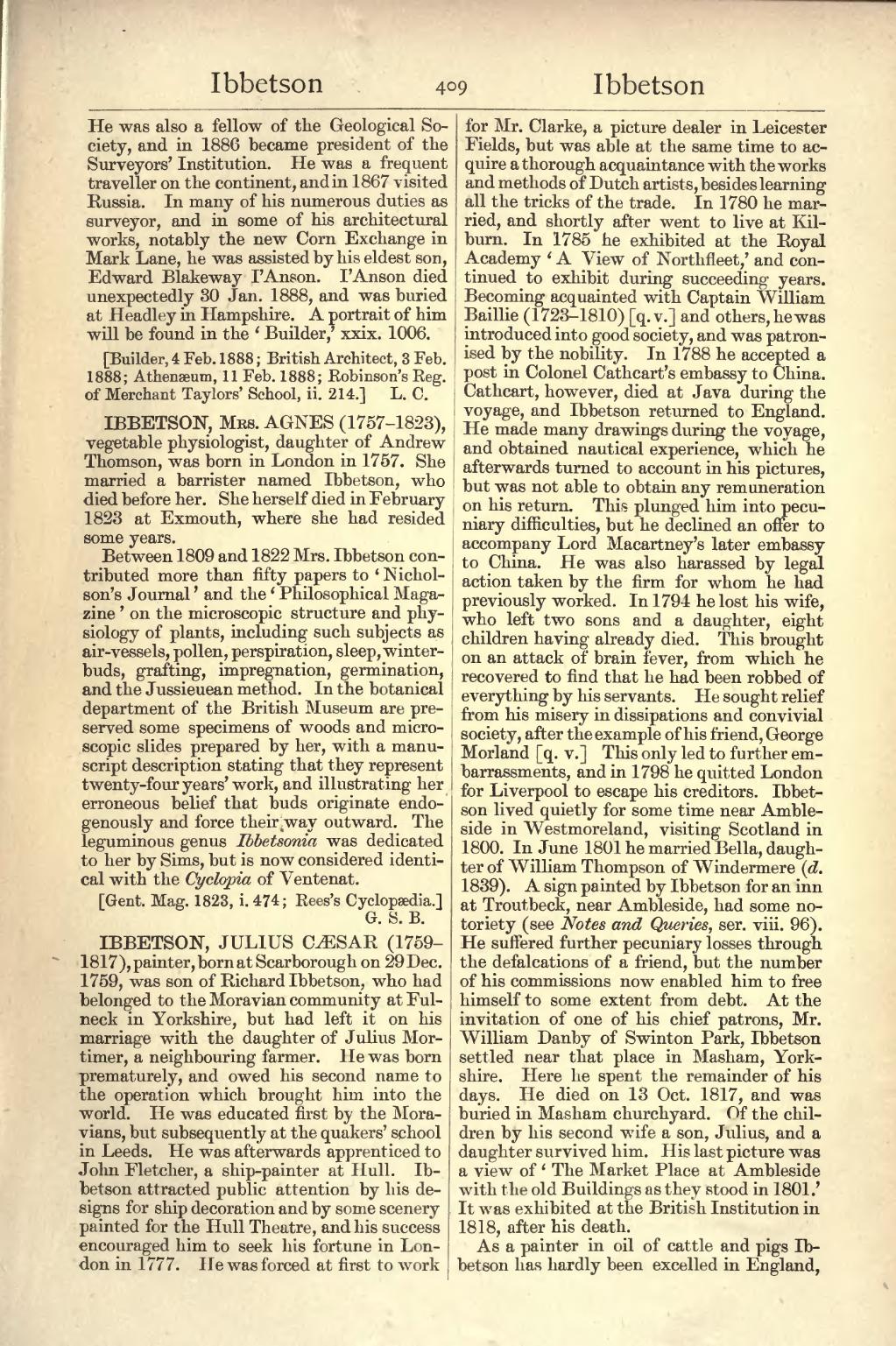He was also a fellow of the Geological Society, and in 1886 became president of the Surveyors' Institution. He was a frequent traveller on the continent, and in 1867 visited Russia. In many of his numerous duties as surveyor, and in some of his architectural works, notably the new Corn Exchange in Mark Lane, he was assisted by his eldest son, Edward Blakeway I'Anson. I'Anson died unexpectedly 30 Jan. 1888, and was buried at Headley in Hampshire. A portrait of him will be found in the 'Builder,' xxix. 1006.
[Builder, 4 Feb. 1888; British Architect, 3 Feb. 1888; Athenæum, 11 Feb. 1888; Robinson's Reg. of Merchant Taylors' School, ii. 214.]
IBBETSON, Mrs. AGNES (1757–1823), vegetable physiologist, daughter of Andrew Thomson, was born in London in 1757. She married a barrister named Ibbetson, who died before her. She herself died in February 1823 at Exmouth, where she had resided some years.
Between 1809 and 1822 Mrs. Ibbetson contributed more than fifty papers to 'Nicholson's Journal' and the 'Philosophical Magazine' on the microscopic structure and physiology of plants, including such subjects as air-vessels, pollen, perspiration, sleep, winter-buds, grafting, impregnation, germination, and the Jussieuean method. In the botanical department of the British Museum are preserved some specimens of woods and microscopic slides prepared by her, with a manuscript description stating that they represent twenty-four years' work, and illustrating her erroneous belief that buds originate endogenously and force their way outward. The leguminous genus Ibbetsonia was dedicated to her by Sims, but is now considered identical with the Cyclopia of Ventenat.
[Gent. Mag. 1823, i. 474; Rees's Cyclopædia.]
IBBETSON, JULIUS CÆSAR (1759–1817), painter, born at Scarborough on 29 Dec. 1759, was son of Richard Ibbetson, who had belonged to the Moravian community at Fulneck in Yorkshire, but had left it on his marriage with the daughter of Julius Mortimer, a neighbouring farmer. He was born prematurely, and owed his second name to the operation which brought him into the world. He was educated first by the Moravians, but subsequently at the quakers' school in Leeds. He was afterwards apprenticed to John Fletcher, a ship-painter at Hull. Ibbetson attracted public attention by his designs for ship decoration and by some scenery painted for the Hull Theatre, and his success encouraged him to seek his fortune in London in 1777. He was forced at first to work for Mr. Clarke, a picture dealer in Leicester Fields, but was able at the same time to acquire a thorough acquaintance with the works and methods of Dutch artists, besides learning all the tricks of the trade. In 1780 he married, and shortly after went to live at Kilburn. In 1785 he exhibited at the Royal Academy 'A View of Northfleet,' and continued to exhibit during succeeding years. Becoming acquainted with Captain William Baillie (1723-1810) [q. v.] and others, he was introduced into good society, and was patronised by the nobility. In 1788 he accepted a post in Colonel Cathcart's embassy to China. Cathcart, however, died at Java during the voyage, and Ibbetson returned to England. He made many drawings during the voyage, and obtained nautical experience, which he afterwards turned to account in his pictures, but was not able to obtain any remuneration on his return. This plunged him into pecuniary difficulties, but he declined an offer to accompany Lord Macartney's later embassy to China. He was also harassed by legal action taken by the firm for whom he had previously worked. In 1794 he lost his wife, who left two sons and a daughter, eight children having already died. This brought on an attack of brain fever, from which he recovered to find that he had been robbed of everything by his servants. He sought relief from his misery in dissipations and convivial society, after the example of his friend, George Morland [q. v.] This only led to further embarrassments, and in 1798 he quitted London for Liverpool to escape his creditors. Ibbetson lived quietly for some time near Ambleside in Westmoreland, visiting Scotland in 1800. In June 1801 he married Bella, daughter of William Thompson of Windermere (d.1839). A sign painted by Ibbetson for an inn at Troutbeck, near Ambleside, had some notoriety (see Notes and Queries, ser. viii. 96). He suffered further pecuniary losses through the defalcations of a friend, but the number of his commissions now enabled him to free himself to some extent from debt. At the invitation of one of his chief patrons, Mr. William Danby of Swinton Park, Ibbetson settled near that place in Masham, Yorkshire. Here he spent the remainder of his days. He died on 13 Oct. 1817, and was buried in Masham churchyard. Of the children by his second wife a son, Julius, and a daughter survived him. His last picture was a view of 'The Market Place at Ambleside with the old Buildings as they stood in 1801.' It was exhibited at the British Institution in 1818, after his death.
As a painter in oil of cattle and pigs Ibbetson has hardly been excelled in England,
